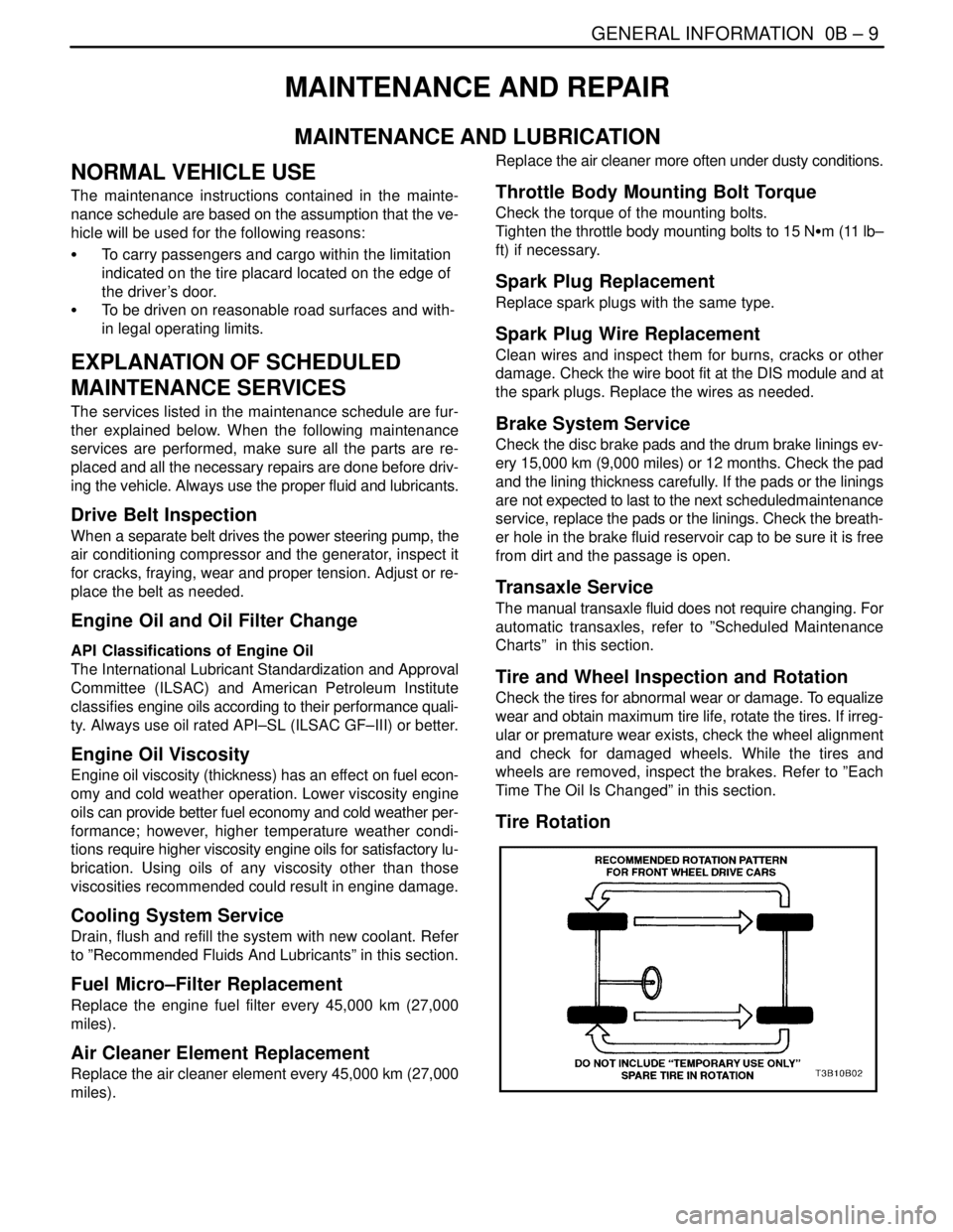2004 DAEWOO LACETTI spark plugs replace
[x] Cancel search: spark plugs replacePage 16 of 2643

GENERAL INFORMATION 0B – 9
DAEWOO V–121 BL4
MAINTENANCE AND REPAIR
MAINTENANCE AND LUBRICATION
NORMAL VEHICLE USE
The maintenance instructions contained in the mainte-
nance schedule are based on the assumption that the ve-
hicle will be used for the following reasons:
S To carry passengers and cargo within the limitation
indicated on the tire placard located on the edge of
the driver’s door.
S To be driven on reasonable road surfaces and with-
in legal operating limits.
EXPLANATION OF SCHEDULED
MAINTENANCE SERVICES
The services listed in the maintenance schedule are fur-
ther explained below. When the following maintenance
services are performed, make sure all the parts are re-
placed and all the necessary repairs are done before driv-
ing the vehicle. Always use the proper fluid and lubricants.
Drive Belt Inspection
When a separate belt drives the power steering pump, the
air conditioning compressor and the generator, inspect it
for cracks, fraying, wear and proper tension. Adjust or re-
place the belt as needed.
Engine Oil and Oil Filter Change
API Classifications of Engine Oil
The International Lubricant Standardization and Approval
Committee (ILSAC) and American Petroleum Institute
classifies engine oils according to their performance quali-
ty. Always use oil rated API–SL (ILSAC GF–III) or better.
Engine Oil Viscosity
Engine oil viscosity (thickness) has an effect on fuel econ-
omy and cold weather operation. Lower viscosity engine
oils can provide better fuel economy and cold weather per-
formance; however, higher temperature weather condi-
tions require higher viscosity engine oils for satisfactory lu-
brication. Using oils of any viscosity other than those
viscosities recommended could result in engine damage.
Cooling System Service
Drain, flush and refill the system with new coolant. Refer
to ”Recommended Fluids And Lubricants” in this section.
Fuel Micro–Filter Replacement
Replace the engine fuel filter every 45,000 km (27,000
miles).
Air Cleaner Element Replacement
Replace the air cleaner element every 45,000 km (27,000
miles).Replace the air cleaner more often under dusty conditions.
Throttle Body Mounting Bolt Torque
Check the torque of the mounting bolts.
Tighten the throttle body mounting bolts to 15 NSm (11 lb–
ft) if necessary.
Spark Plug Replacement
Replace spark plugs with the same type.
Spark Plug Wire Replacement
Clean wires and inspect them for burns, cracks or other
damage. Check the wire boot fit at the DIS module and at
the spark plugs. Replace the wires as needed.
Brake System Service
Check the disc brake pads and the drum brake linings ev-
ery 15,000 km (9,000 miles) or 12 months. Check the pad
and the lining thickness carefully. If the pads or the linings
are not expected to last to the next scheduledmaintenance
service, replace the pads or the linings. Check the breath-
er hole in the brake fluid reservoir cap to be sure it is free
from dirt and the passage is open.
Transaxle Service
The manual transaxle fluid does not require changing. For
automatic transaxles, refer to ”Scheduled Maintenance
Charts” in this section.
Tire and Wheel Inspection and Rotation
Check the tires for abnormal wear or damage. To equalize
wear and obtain maximum tire life, rotate the tires. If irreg-
ular or premature wear exists, check the wheel alignment
and check for damaged wheels. While the tires and
wheels are removed, inspect the brakes. Refer to ”Each
Time The Oil Is Changed” in this section.
Tire Rotation
Page 17 of 2643

0B – 10IGENERAL INFORMATION
DAEWOO V–121 BL4
SCHEDULED MAINTENANCE CHARTS
Engine
Maintenance ItemMaintenance Interval
Kilometers or time in months, whichever comes first
x 1,000 km1153045607590105120
x 1,000 miles0.6918273645546372
Months–1224364860728496
Drive belts (Alternator, power steering
and A/C belt)IIII
Engine oil & engine oil filter (1) (3)IRRRRRRRR
Cooling system hose & connectionsIIIIIIII
Engine coolant (3)IIIRIIRII
Fuel filterRR
Fuel line and connectionsIIIIIIII
Air cleaner element (2)IIRIIRII
Spark plugs (1.4D/1.6D)IRIRIRIR
Spark plugs (1.8D)IRIR
Spark plug wiresReplace every 90,000 km(54,000 miles)
EVAP canister, vapor lines & solenoid
valve filterII
PCV systemIIII
Timing beltlRlR
Chart Symbols:
I –Inspect, and if necessary correct, clean, replenish or adjust.
R – Replace or change:
(1) Change the engine oil and oil filter every 7,500 km (4,500 miles) or 6months, whichever comes first, if the vehicle is
operated under any of the following conditions:
S Short distance driving.
S Extensive idling.
S Driving on dusty roads.
(2) Inspect the air cleaner element every 7,500 km (4,500 miles) or 6 months if driving under dusty conditions. If necessary,
correct, clean or replace.
(3) Refer to ”Recommended Fluids And Lubricants”
Note : Check the engine oil and radiator coolant levels every week.
Page 331 of 2643

ENGINE CONTROLS 1F – 85
DAEWOO V–121 BL4
IGNITION SYSTEM CHECK (1.4L/1.6L DOHC)
Circuit Description
The Electronic Ignition (EI) system uses a waste spark
method of spark distribution. In this type of EI system, the
Crankshaft Position (CKP) sensor is mounted to the oil
pump near a slotted wheel that is a part of the crankshaft
pulley. The CKP sensor sends reference pulses to the en-
gine control module (ECM). The ECM then triggers the EI
system ignition coil. Once the ECM triggers the EI system
ignition coil, both of the connected spark plugs fire at the
same time. One cylinder is on its compression stroke at
the same time that the other is on the exhaust stroke, re-
sulting in lower energy needed to fire the spark plug in the
cylinder on its exhaust stroke.
This leaves the remainder of the high voltage to be used
to fire the spark plug in the cylinder on its compression
stroke. Since the CKP sensor is in a fixed position, timing
adjustments are not possible or needed.
Test Description
The number(s) below refer to step(s) on the diagnostictable.
2. It is important to check for the presence of spark to
all of the cylinders to isolate the problem to either
EI system ignition coil inputs or outputs.
5. In checking the ECM outputs for the electronic
spark timing signal, it recommended to use an os-
cilloscope to view the varying voltage signals. In
measuring these outputs with a voltmeter, intermit-
tent errors may occur that cannot be seen by a volt-
meter.
6. After confirming ECM inputs for the electronic spark
timing to the EI system ignition coil are OK, it can
be determined that a faulty EI system ignition coil is
at fault.
11. After confirming proper CKP sensor inputs to the
ECM and no wiring problems present, it can be de-
termined that the ECM is at fault.
24. This step, along with step 25, checks for battery
voltage and a ground to the EI system ignition coil.
Ignition System Check (1.4L/1.6L DOHC)
CAUTION : Use only electrically insulated pliers when handling ignition wires with the engine running to prevent
an electrical shock.
Step
ActionValue(s)YesNo
11. Remove the spark plugs.
2. Inspect for wet spark plugs, cracks, wear, im-
proper gap, burned electrodes, or heavy de-
posits.
3. Replace the spark plugs as needed.
Is the repair complete?–System OKGo to Step 2
2Check for the presence of spark from all of the igni-
tion wires while cranking the engine.
Is spark present from all of the ignition wires?–System OKGo to Step 3
31. Measure the resistance of the ignition wires.
2. Replace any ignition wire(s) with a resistance
above the value specified.
3. Check for the presence of spark from all of the
ignition wires.
Is spark present from all of the ignition wires?30,000 WSystem OKGo to Step 4
4Is spark present from at least one of the ignition
wires, but not all of the ignition wires?–Go to Step 5Go to Step 12
51. Turn the ignition OFF.
2. Disconnect the Electronic Ignition (EI) system
ignition coil connector.
3. While cranking the engine, measure the volt-
age at the EI system ignition coil connector
terminal 1.
Does the voltage fluctuate within the values speci-
fied?0.2–2.0 vGo to Step 6Go to Step 7
Page 335 of 2643

ENGINE CONTROLS 1F – 89
DAEWOO V–121 BL4
Ignition System Check (1.8L DOHC)
CAUTION : Use only electrically insulated pliers when handling ignition wires with the engine running to prevent
an electrical shock.
Step
ActionValue(s)YesNo
11. Remove the spark plugs.
2. Inspect for wet spark plugs, cracks, wear, im-
proper gap, burned electrodes, or heavy de-
posits.
3. Replace the spark plugs as needed.
Is the repair complete?–System OKGo to Step 2
2Check for the presence of spark from all of the igni-
tion wires while cranking the engine.
Is spark present from all of the ignition wires?–System OKGo to Step 3
31. Measure the resistance of the ignition wires.
2. Replace any ignition wire(s) with a resistance
above the value specified.
3. Check for the presence of spark from all of the
ignition wires.
Is spark present from all of the ignition wires?30,000 WSystem OKGo to Step 4
4Is spark present from at least one of the ignition
wires, but not all of the ignition wires?–Go to Step 5Go to Step 12
51. Turn the ignition OFF.
2. Disconnect the Electronic Ignition (EI) system
ignition coil connector.
3. While cranking the engine, measure the volt-
age at the EI system ignition coil connector
terminal 1.
Does the voltage fluctuate within the values speci-
fied?0.2–2.0 vGo to Step 6Go to Step 7
6While cranking the engine, measure the voltage at
the EI system ignition coil connector terminal 3
Does the voltage fluctuate within the values speci-
fied?0.2–2.0 vGo to Step 10Go to Step 8
7Check for an open in the wire from the EI system
ignition coil connector terminal 1 to the engine con-
trol module (ECM) connector terminal M35 or M51.
Is the problem found?–Go to Step 9Go to Step 11
8Check for an open in the wire from the EI system
ignition coil connector terminal 3 to the ECM connec-
tor terminal M1 or M33.
Is the problem found?–Go to Step 9Go to Step 11
91. Repair the wiring as needed.
2. Connect the EI system ignition coil connector.
3. Check for the presence of spark from all of the
ignition wires.
Is spark present from all of the ignition wires?–System OK–
Page 435 of 2643

ENGINE CONTROLS 1F – 189
DAEWOO V–121 BL4
StepNo Yes Value(s) Action
71. Turn the engine OFF.
2. Install a fuel pressure gauge to the fuel rail.
3. Observe the fuel pressure with the engine run-
ning.
Is the fuel pressure within the specified value?284–325 kPa
(41–47 psi)Go to Step 8Go to
”Fuel System
Diagnosis”
8Check the fuel for contamination.
Is the fuel OK?–Go to Step 9Go to Step 10
9Check for a basic engine problem and repair as nec-
essary.
Is the repair complete?–Go to Step 27–
10Replace the contaminated fuel.
Is the repair complete?–Go to Step 27–
111. Turn the engine OFF.
2. Disconnect the fuel injector harness connector.
3. Install a spark tester on cylinder #1 spark plug
cable.
4. Crank the engine and check for spark.
5. Repeat the above procedure on cylinders #2,
#3 and #4.
Is a spark observed on all four spark plug cables?–Go to Step 12Go to Step 20
12Replace any malfunctioning spark plugs if neces-
sary.
Is the repair complete?–Go to Step 27Go to Step 13
131. Turn the engine OFF.
2. Disconnect the fuel injector connectors from
the injectors.
3. Install an injector test light on the injector har-
ness connector for the cylinders that had mis-
fired.
4. Crank the engine and note the test light.
Does the injector test light blink?–Go to Step 14Go to Step 15
14Perform the Fuel Injector Balance Test.
Are the fuel injectors OK?–Go to Step 9Go to Step 16
151. Disconnect the injector test light.
2. With a test light connected to ground, probe
the ignition feed terminal 2 of the injector har-
ness connector for each cylinder that had mis-
fire.
3. Crank the engine.
Does the test light illuminate?–Go to Step 17Go to Step 19
16Replace any malfunctioning fuel injectors.
Is the repair complete?Go to Step 27–
17Check the affected fuel injector driver circuit at termi-
nals 59, 89, 90, and 60 for an open, short, or short
to voltage.
Is a problem found?–Go to Step 18Go to Step 24
18Repair the open or the shorted fuel injector driver cir-
cuit.
Is the repair complete?–Go to Step 27–
Page 439 of 2643

ENGINE CONTROLS 1F – 193
DAEWOO V–121 BL4
StepNo Yes Value(s) Action
71. Turn the engine OFF.
2. Install a fuel pressure gauge to the fuel rail.
3. Observe the fuel pressure with the engine run-
ning.
Is the fuel pressure within the specified value?284–325 kPa
(41–47 psi)Go to Step 8Go to
”Fuel System
Diagnosis”
8Check the fuel for contamination.
Is the fuel OK?–Go to Step 9Go to Step 10
9Check for a basic engine problem and repair as nec-
essary.
Is the repair complete?–Go to Step 27–
10Replace the contaminated fuel.
Is the repair complete?–Go to Step 27–
111. Turn the engine OFF.
2. Disconnect the fuel injector harness connector.
3. Install a spark tester on cylinder #1 spark plug
cable.
4. Crank the engine and check for spark.
5. Repeat the above procedure on cylinders #2,
#3 and #4.
Is a spark observed on all four spark plug cables?–Go to Step 12Go to Step 20
12Replace any malfunctioning spark plugs if neces-
sary.
Is the repair complete?–Go to Step 27Go to Step 13
131. Turn the engine OFF.
2. Disconnect the fuel injector connectors from
the injectors.
3. Install an injector test light on the injector har-
ness connector for the cylinders that had mis-
fired.
4. Crank the engine and note the test light.
Does the injector test light blink?–Go to Step 14Go to Step 15
14Perform the Fuel Injector Balance Test.
Are the fuel injectors OK?–Go to Step 9Go to Step 16
151. Disconnect the injector test light.
2. With a test light connected to ground, probe
the ignition feed terminal 2 of the injector har-
ness connector for each cylinder that had mis-
fire.
3. Crank the engine.
Does the test light illuminate?–Go to Step 17Go to Step 19
16Replace any malfunctioning fuel injectors.
Is the repair complete?Go to Step 27–
17Check the affected fuel injector driver circuit at termi-
nals 59, 89, 90, and 60 for an open, short, or short
to voltage.
Is a problem found?–Go to Step 18Go to Step 24
18Repair the open or the shorted fuel injector driver cir-
cuit.
Is the repair complete?–Go to Step 27–
Page 668 of 2643

1F – 422IENGINE CONTROLS
DAEWOO V–121 BL4
8. Check fuel for water, alcohol, etc.
9. A basic engine problem that affects all cylinders is
the only possibility at this point. (Cam timing,
throttle body leak, restricted air flow, etc.)
11. Tests the ignition system voltage output using a
spark tester.
12. Replace any spark plugs that are worn, cracked or
fouled.
13. Checks for voltage at the ignition feed circuit.
18. Whenever the driver circuit is shorted to ground,
the light will be on steady. When the driver circuit is
shorted to voltage or open, the light will be off.19. Since voltage is supplied to the fuel injector on a
single circuit, the malfunction could only be a poor
connection or open in the fuel injector harness. An
open before the harness would result in an ”Engine
Cranks But Will Not Run” complaint.
28. Before replacing the ECM, check terminals for im-
proper mating, broken locks, or physical damage to
the wiring harness. The replacement ECM must be
reprogrammed. Refer to the latest Techline proce-
dure for ECM reprogramming.
DTC P0300 – Multiple Cylinder Misfire Detected
StepActionValue(s)YesNo
1Perform an On–Board Diagnostic (EOBD) System
Check.
Was the check performed?–Go to Step 2Go to
”On–Board
Diagnostic Sys-
tem Check”
21. Install a scan tool to the Data Link Connector
(DLC).
2. Turn the ignition ON, with the engine OFF.
3. Request Diagnostic Trouble Codes (DTCs)
Are DTCs P0201, P0202, P0203, P0204 set?–Go to applica-
ble DTCGo to Step 3
31. Perform a visual/physical inspection.
2. Make any repairs that are necessary.
Is the repair complete?–Go to Step 27Go to Step 4
4Start the engine and allow it to idle.
Are any Misfire Current counters incrementing?–Go to Step 5Go to Step 6
5Are all counters equal (within a percentage of each
other)?–Go to Step 7Go to Step 11
61. Turn the ignition ON, with the engine OFF.
2. Review the Freeze Frame data, and note the
parameters.
3. Operate the vehicle within the Freeze Frame
conditions and conditions for setting this DTC
as noted.
Are any Misfire Current counters incrementing?–Go to Step 5Go to
”Diagnostic
Aids”
71. Turn the engine OFF.
2. Install a fuel pressure gauge to the fuel rail.
3. Observe the fuel pressure with the engine run-
ning.
Is the fuel pressure within the specified value?284–325 kPa
(41–47 psi)Go to Step 8Go to
”Fuel System
Diagnosis”
8Check the fuel for contamination.
Is the fuel OK?–Go to Step 9Go to Step 10
9Check for a basic engine problem and repair as nec-
essary.
Is the repair complete?–Go to Step 27–
10Replace the contaminated fuel.
Is the repair complete?–Go to Step 27–
Page 669 of 2643

ENGINE CONTROLS 1F – 423
DAEWOO V–121 BL4
StepNo Yes Value(s) Action
111. Turn the engine OFF.
2. Disconnect the fuel injector harness connector.
3. Install a spark tester on cylinder #1 spark plug
cable.
4. Crank the engine and check for spark.
5. Repeat the above procedure on cylinders #2,
#3 and #4.
Is a spark observed on all four spark plug cables?–Go to Step 12Go to Step 20
12Replace any malfunctioning spark plugs if neces-
sary.
Is the repair complete?–Go to Step 27Go to Step 13
131. Turn the engine OFF.
2. Disconnect the fuel injector connectors from
the injectors.
3. Install an injector test light on the injector har-
ness connector for the cylinders that had mis-
fired.
4. Crank the engine and note the test light.
Does the injector test light blink?–Go to Step 14Go to Step 15
14Perform the Fuel Injector Balance Test.
Are the fuel injectors OK?–Go to Step 9Go to Step 16
151. Disconnect the injector test light.
2. With a test light connected to ground, probe
the ignition feed terminal 2 of the injector har-
ness connector for each cylinder that had mis-
fire.
3. Crank the engine.
Does the test light illuminate?–Go to Step 17Go to Step 19
16Replace any malfunctioning fuel injectors.
Is the repair complete?Go to Step 27–
17Check the affected fuel injector driver circuit at termi-
nals M25, M22, M24, and M11 for an open, short, or
short to voltage.
Is a problem found?–Go to Step 18Go to Step 24
18Repair the open or the shorted fuel injector driver cir-
cuit.
Is the repair complete?–Go to Step 26–
19Repair the open ignition feed circuit between the fuel
injector harness connector and the fuel injector con-
nector.
Is the repair complete?–Go to Step 27–
20Measure the resistance of the spark plug cable that
the spark plug tester did not spark.
Is the resistance of the spark plug cable less than the
specified value?30,000 WGo to Step 21Go to Step 25
21Inspect the Engine Control Module (ECM) connec-
tor and connections.
Are the connections OK?–Go to Step 22Go to Step 23
22Check the affected cylinders ignition control circuit
for an open or short and repair as necessary.
Is the repair complete?–Go to Step 27Go to Step 26